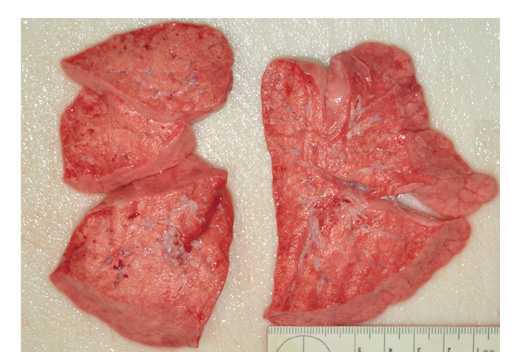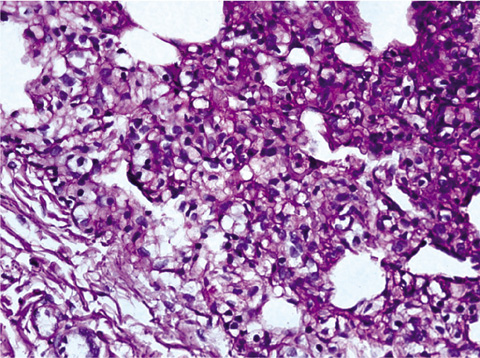Korean J Leg Med.
2012 Nov;36(2):178-181. 10.7580/KoreanJLegMed.2012.36.2.178.
Death of a Severe Underweight Infant with Pulmonary Interstitial Glycogenosis
- Affiliations
-
- 1Division of Forensic Medicine, National Forensic Service, Seoul, Korea. lillu79@korea.kr
- 2Department of Forensic Medicine, Korea University College of Medicine, Seoul, Korea.
- KMID: 2305478
- DOI: http://doi.org/10.7580/KoreanJLegMed.2012.36.2.178
Abstract
- Pulmonary interstitial glycogenosis (PIG) is a very rare interstitial lung disease in infants. It is poorly understood, but its pathological features are distinct; they include uniform alveolar septal thickening, caused by a group of oval to spindle-shaped cells containing abundant glycogen, without apparent inflammation or fibrosis. PIG is usually associated with a good prognosis. However, in the present report, we describe the case of a 5-month-old male infant who died due to PIG; he was severely underweight and not administered proper treatment or care. The pathology of PIG was determined following a medico-legal autopsy.
MeSH Terms
Figure
Cited by 1 articles
-
Determining the Cause of Natural Death: A Case of Previously Unknown Sturge-Weber Syndrome
Moon-Young Kim, Hanna Kim, Sohyung Park, Kyungmoo Yang, Sung-Hye Park, Soong Deok Lee
Korean J Leg Med. 2015;39(3):67-72. doi: 10.7580/kjlm.2015.39.3.67.
Reference
-
1. Deterding RR. Infants and young children with children's interstitial lung disease. Pediatr Allergy Immunol Pulmonol. 2010. 23:25–31.2. Dishop MK. Paediatric interstitial lung disease: classification and definitions. Paediatr Respir Rev. 2011. 12:230–237.3. Clement A, Eber E. Interstitial lung diseases in infants and children. Eur Respir J. 2008. 31:658–666.4. Canakis AM, Cutz E, Manson D, O'Brodovich H. Pulmonary interstitial glycogenosis: a new variant of neonatal interstitial lung disease. Am J Respir Crit Care Med. 2002. 165:1557–1565.5. Onland W, Molenaar JJ, Leguit RJ, et al. Pulmonary interstitial glycogenosis in identical twins. Pediatr Pulmonol. 2005. 40:362–366.6. Deutsch GH, Young LR. Histologic resolution of pulmonary interstitial glycogenosis. Pediatr Dev Pathol. 2009. 12:475–480.7. Radman MR, Goldhoff P, Jones KD, et al. Pulmonary interstitial glycogenosis: an unrecognized etiology of persistent pulmonary hypertension of the newborn in congenital heart disease? Pediatr Cardiol. 2012.8. King BA, Boyd JT, Kingma PS. Pulmonary maturational arrest and death in a patient with pulmonary interstitial glycogenosis. Pediatr Pulmonol. 2011. 46:1142–1145.
- Full Text Links
- Actions
-
Cited
- CITED
-
- Close
- Share
- Similar articles
-
- Effect of interferon-gamma treatment on interstitial pneumonia in a patient with severe combined immunodeficiency
- Idiopathic Interstitial Pneumonias: Radiologic Findings
- Successful Treatment of a Term Neonate Developing Severe Pulmonary Interstitial Emphysema Unrelated to Mechanical Ventilation; the First Reported Case in Korea
- A case of localized persistent interstitial pulmonary emphysema
- A Case of Severe Pulmonary Complication and ARDS Secondary to Peanut Aspiration in 15 Month Old Male





